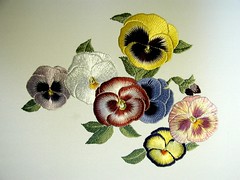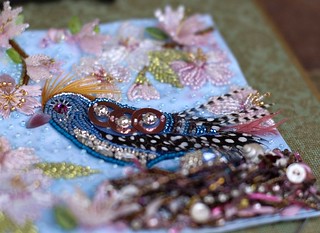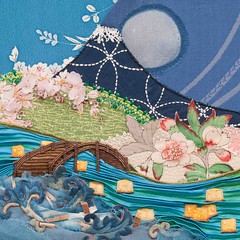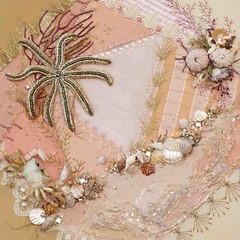If you had to stitch 118 goldwork leaves on a honeysuckle vine, how many leaves do you think it would take before you felt like they began to flow from your needle?
All of the leaves on this honeysuckle vine have a very predictable shape so it shouldn't take too long, right?
Oh, if it were only that easy. There are so many variables to account for and I am only now beginning to find a rhythm...on leaf number 86.
Working with Japanese gold thread, couching stitches every 2mm or so, maintaining the twist of the gold, manipulating the koma in a predictable and practiced way, making good corners, etc.
There's a lot to understand. First, the thread.
Japanese gold thread comes in a hank and it must be split in half and wound onto two wooden spools called koma. It is very important that the thread be wound onto the spool under tension. I am using size number 3 and it's imitation gold...

To understand the importance of having the thread under tension, you have to understand how the thread is made. Gold (real or imitation) is laminated to mulberry paper, cut into strips and then wrapped around a silk core.
While stitching, the wraps can become loose allowing more of the silk core to show through. This also makes the thread less taut and more wimpy.
Here is a picture of the gold thread that has loosened near the cut end...

By winding the koma, I can tighten and untighten the twist of the thread. In the picture below, I have tightened the gold thread; the wraps are closer together and the thread takes on a wire-like quality.

This is how you want the thread to be when you couch it down. The gold thread shines to optimal effect when the thread is laid this way.
That being said, to turn corners the thread needs to be softened in order to make sharp points and corners. My honeysuckle leaves don't require as sharp a corners as my cherry blossom petals but I still have many corners to turn. Softening the twist of the gold at the turn keeps the thread from crimping. Once I've made the turn, I have to retighten the twist of the thread again and off I go to the next turn.
This means that there is a constant manipulation of the thread wrapped around the koma as I stitch. Wrapping to tighten the thread, couching the thread, and then loosening the wraps at the corner to allow for an easier turn, and then tightening the thread again to couch down the straightaway section of the leaf.

This dance of the koma, together with the starting and ending the threads for each leaf, means that each leaf can take a good deal of time. For me, about 22 minutes. (*wink* That's what that Toggl timer is for).
Next Japanese embroidery post, I'll try to post some pictures of turning corners since a few of you have asked about that.
Needless to say, these koma are very handy tools and I use them anytime I need to couch a non-stitchable thread on a project. This extra set of hands allows you to keep your thread under good tension so that the couched line is nice and smooth.
Koma are most often sold in pairs and can be made from a variety of woods. The most important thing when selecting koma is the weight of the wood that is used. The heavier the better.
The weight plus the squared off ends keeps the spool from rolling and helps to anchor the koma firmly in place. They really are like a second pair of hands.
You can buy koma from the Japanese embroidery center here .

But don't expect to master their use overnight.
Hundreds of curlicues...118 leaves, and hundreds more turns...
Practice is the teacher.
That's one thing that the Japanese understand. Ten phases to teach you. To test you. And then you are ready to begin.
The hardest part for me is staying in the chair. Resisting the temptation to do something else. And no, it doesn't get easier.
Showing up. Sitting down. Keeping my butt in the chair. Stitching for a minimum of two hours every day.
It's starting to happen. Competence. Predictability. Flow.
The Japanese understand that there are no short cuts to gaining skill. It's work; it can be hard.
I'm getting better at the struggle. I'm winning more and more. My butt is staying in the chair.

























23 comments:
I "sew" admire your patience you are learning and practicing with this amazing Japanese Stitchery. There is always so much to learn when I visit you Susan Dear. Bless you...
This is amazing! some magical skills.. Love it
I'm not at all surprised it has taken up to leaf 86. I've tried similar techniques, and there's always something more to master..!
Great post as always Susan. Love that word wimpy-- perfect for this situation and explained well.. Keep them coming.
Gorgeous pictures of beautiful stitching as always. The timing of this post is perfect for me. I am just about to start my 4th attempt on the large goldwork fan spine on Sensu. If I don't get it right this time, it's likely to become my nemesis! I'm hoping that reading your post has got me into right mental state to stop procrastinating :-)
I am in awe of your amazing needle work and your knowledge. Your blog is a lovely place to be.
Beautiful post. Thank your for sharing your experience with us.
Stunning work, as always! I'm perpetually amazed by your skill and patience.
Can't wait to see what this is like when finished.
I'm learning so much! Thank you.
Well, if "I" had to stitch 118 goldwork leaves on a honeysuckle vine, it would take about 6 before I stuck the needle in my eye!
Maureen made me LOL! Great blog post as usual. I always learn something from your posts and I appreciate that very much, even if I never try goldwork.
118 leaves Susan, I'm struggling with 6 goldwork bugs. Your photos are beautiful and the story behind them so educational. Thank you..
Hi Susan thanks for your comment about untwisting to turn corners. I thought I was going nuts when I had to do this. All my brain seemed to register at first was keep the gold twisted under tension. Everything should be EASY after that. I love gold work but it's not easy. Can't wait for your turning corners post. I need all the help I can get. Stitching the gold work flower cart lots of corners on that. Keep up the Fabulous work.
You are doing a wonderful job there Susan, I'm impressed. Using the koma to put a twist on and off the gold to create good tension and corners is very difficult. It's one of the hardest things for me to teach students, as you say, lots of patience and lots of practice makes perfect.
I too am anxious to see the turning... will have to think about the wood things. BUT I do love couching. The more I age the more I see the value in simple repetitive actions. It does have a rhythm.. It's also easier now to keep my butt on a chair...LOL
I have just made a start on the gold work - OMG, so many corners! Even with the second pair of hands I feel at least one more hand would be useful.
You are doing a beautiful job on Sake Boxes, keep it up :-)
Susan, you are amazing! You have such patience and skill. This is going to be a real work of art when you finish. Now I know why I never hear from you! You're way too busy stitching.
Susan, your posts are such a joy to read. I very much appreciate your sharing the fine details of your work. I have studied a lovely book called The Techniques of Japanese Embroidery by Shuji Tamura and therefore am able to recognize the elements from your pictures: the stitch outlines, the stitches you use, the classic designs, the fabric and the equipment. What fun to see your work in detail. Thank you so much.
what a great job you are doing with these leaves, Susan they are amazing
How beautiful and such great educational explanations of the techniques used. Thank you! I took a couching class once and was impressed with myself. Needless to say, I think it was kindergarten beginner level compared to this, LOL! Can't wait to see your next post.
OH MY! That is stunning!
I have never seen anything like this... it is amazing!! Thanks so much for going into such detail and explaining the process.
I recently started a weekly Stitchery Link Party and I would love to have you come link up this post and share your incredible work with my readers. I'm sure they would enjoying reading as much as I have.
http://www.supermomnocape.com/2015/04/27/vintage-embroidery-monday-and-stitchery-link-party/
This is so beautiful Susan! Lots of leaves I know but absolutely stunning! Amazing job! Have fun on the other 36 leaves!
Post a Comment